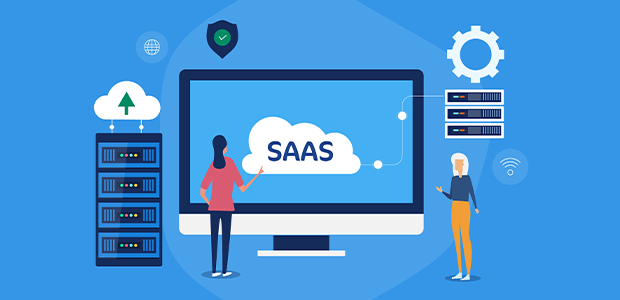
The SaaS industry rising: why investing in service is a good idea
The software as a service (SaaS) market is vast and versatile. It unites a broad variety of products and companies, from Zoom and Salesforce to Adobe and Dropbox. There is something for an investor with any aspirations, be it simply to grow capital or to create something defining and revolutionary. If, as an investor, you have a preferred industry, you are very likely to find some SaaS startups within it to consider.
My fascination with SaaS comes from personal experience. With our firm's recent investment in AppMagic, a mobile analytics provider ranked #3 in terms of customer base, I took a deeper look at the SaaS market. As a result, I have a few insights on why investors should be attracted to this sector that I want to share.
The SaaS Industry Is Growing
Growth is a magnet for investors, and the SaaS market is undeniably on an upward trajectory. Especially now, when its rise is fueled by the integration of artificial intelligence (AI) and machine learning (ML) tools. AI and ML have significantly enhanced SaaS solutions, driving further innovation, efficiency, and convenience.
Fortune Business Insights estimates the global SaaS market size at $274 billion in 2023, projected to grow to $1,229 billion by 2032 with a Compound Annual Growth Rate (CAGR) of 18.4%. These impressive numbers make SaaS a much more attractive proposition compared to stagnant or declining industries where investors have to be more cautious.
Global Reach and Large Addressable Market
Compared to traditional software businesses with high upfront fees, SaaS companies typically gain broader access to their audience due to lower initial prices. It aligns with consumer preferences: SaaS caters to the modern desire for affordability and flexibility. Instead of a hefty upfront price, consumers gain access to tools with lower monthly fees, instant usability, and the freedom to cancel if needed.
Flexible, tiered subscription pricing is another key factor. It allows businesses (especially B2B) to start small and upgrade as they grow or use the platform more heavily. Lower entry points significantly expand the pool of potential customers, increasing the total addressable market.
Easy to Scale and Expand Globally
Scalability is built-in with SaaS: the infrastructure of SaaS allows for easy expansion into new markets without significant additional resources. SaaS solutions can serve a global customer base without requiring extensive physical infrastructure or substantial regional investments. SaaS businesses benefit from an efficient distribution model that eliminates the need for physical delivery. It not only simplifies access to a global audience but also reduces operational costs and accelerates the time-to-market for new features.
The foundations of the product in terms of code and design also stay the same, no matter what part of the world it's going to be accessed from. Slack or Miro are going to look and work similarly from country to country.
SaaS tools are inherently efficiently expandable with the cost of serving each customer decreasing as the company grows. Over the long term, the growth potential of SaaS businesses generally leads to high profit margins and consistently growing cash flows. No wonder, Saas companies are a good catch for any investor.
Predictable Revenue Streams
SaaS businesses thrive on predictable, recurring revenue streams. Unlike a one-time purchase of a downloadable movie, a monthly subscription to Netflix, for example, creates a repeatable and secure source of income. This predictability allows SaaS companies to forecast future earnings with greater accuracy.
Furthermore, they can grow this revenue stream in two key ways: by acquiring new subscribers and by strategically adjusting pricing models. This flexibility empowers them to adapt to market trends and optimise their income potential, making such businesses more financially sustainable and stable.
Risk Management
Since SaaS companies are highly scalable and create a steady revenue stream, they can enhance an investor's overall portfolio's cash flow stability and predictability, effectively mitigating liquidity risks.
Besides, for an investor, the global nature of the SaaS industry effectively mitigates country-related risks. The worldwide reach also acts as a hedge, as the success of a SaaS company does not rely solely on the performance of any particular economy.
Good Match for VC Funding
To attract new customers, SaaS companies have to significantly invest in marketing and sales. As these companies aim for aggressive growth and gaining market share, substantial spending on customer acquisition is necessary.
Given the subscription model, where customers pay gradually, this results in a cash flow gap that widens with increased growth rates. Consequently, venture capital funding can be pivotal in providing the necessary capital to support growth, while simultaneously benefiting investors who seek returns from scaling businesses.
Despite operating across various industries, SaaS companies typically use standardised metrics such as customer acquisition cost (CAC), churn rate, annual recurring revenue (ARR), and others. These standardised metrics facilitate investor due diligence and enable effective benchmarking between companies.
Taking all the above into account, if you are on a hunt for the next unicorn, you are more likely to meet one in the SaaS field. Chasing unicorns aside, SaaS companies should be highly attractive to investors in general. In this category, businesses have all the qualities that VCs value – easy scalability, predictable revenue streams, lower risks, a time-tested and flexible business model, and growing demand.

